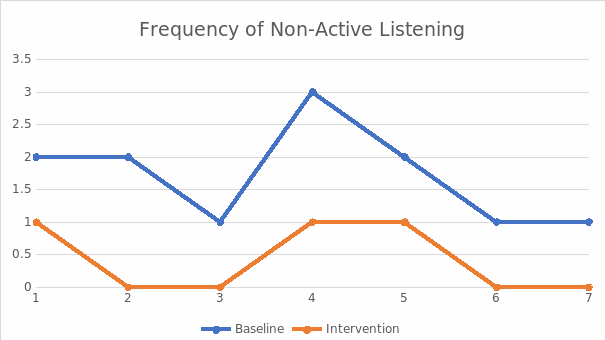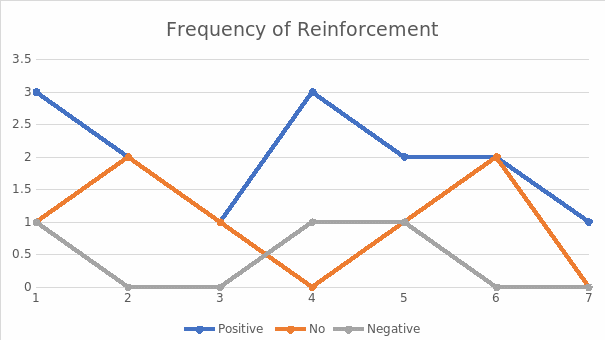Target Behavior
Active listening presupposes an intentional focus on the listening process during communicative interactions (Arnold & Boggs, 2019). The outcomes of an active listening act are a well-informed response and feedback on the given information stretching beyond the simple acknowledgment of input information. This process is empathetic and supportive, giving the interlocutor a sense of comprehension and involvement in the discussion.
Treatment Method
Positive reinforcement was the selected method of treatment. Martin and Pear (2019) defined a positive reinforcer as a reward (consumable, activity, manipulative, possessional, or social) presented immediately after following the behavior. The reinforcer’s provision serves as a stimulus for engaging in the desired behavior, thus increasing the likelihood of the new behavior’s adoption.
Treatment Period
The treatment period lasted one week, from April 11, 2002, to April 18, 2022.


Experiment Narrative
The experimental design followed the AB design, with the first measurement made at the baseline (A) and the second measurement made after the intervention (B). The researcher then compared the pre- and post-experimental data for the occurrence of the target behavior, assessing the treatment approach’s effectiveness.
Dimension
The dimensions measured after the intervention included the number of non-active listening episodes within the treatment phase and the duration of each dialogue with the interlocutors. The participant also held a diary of communicative acts, evaluating each listening episode on a 5-point Likert scale, with “1” meaning little insight and “5” meaning much insight. The post-intervention measurement also involved a comparison of these dimensions with the baseline data.
Summary of Treatment
The participant informed their peers and colleagues about the experiment and agreed on the positive reinforcement in the form of verbal acknowledgment of active listening and praise. Everyone to whom the participant talked needed to give a verbal assessment of the depth of insight and attentiveness. If the assessment was positive, the researcher received a positive social reinforcer. In the absence of assessment or negative feedback, the researcher marked the absence of a reinforcer or a negative reinforcer.
References
Arnold, E. C., & Boggs, K. U. (2019). Interpersonal relationships: Professional communication skills for nurses. Elsevier Health Sciences.
Martin, G., & Pear, J. (2019). Behavior modification. (11th ed.). Routledge.
